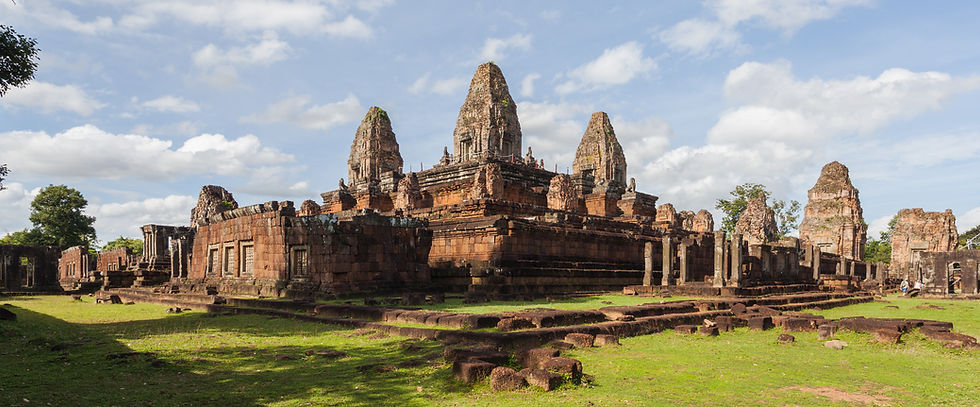Women of Angkor: celestial or real?
- Shila Desai
- Nov 29, 2021
- 4 min read
New research holds tantalising clues.
On a visit to Angkor Wat, I was astonished by the sheer number of unique bas relief apsaras—more than 3,000 to be precise. What was their significance?

In Hindu and Buddhist mythology, an apsara (Sanskrit apsaras) is a female spirit of the clouds and waters. They figure prominently in the sculpture, dance, literature, and painting of many South Asian and Southeast Asian cultures. Within the context of Angkor Wat (8th–13th centuries CE), for 150 years, scholars have believed the divine figures represent ocean foam generated by a Hindu creation myth about victory of good over evil.

At the beginning of time before the universe was created, devas (gods) were fighting the asuras (demons) in order reclaim order and power. To do so, they needed to release the elixir of life (amrita) from the earth. However, the elixir could only be released if the gods and demons worked together. Both sides were aware that once the amrita was released, a battle to own it would ensue.
In the relief above, the two sides are churning the ocean of milk, a sort of tug-of-war with the Naga or serpent king as their divine rope. Once the elixir is released, Indra, the Vedic god who is considered the king of all the gods, is seen descending from heaven to catch it and save the world from the demons. The foam from the churning produces the celestial nymphs, or apsaras, seen on either side of Vishnu, above the gods and demons.

Apsaras is a catch-all term since not all Angkorian female images are apsaras. In keeping with the Hindu association of apsaras to dance, only those shown dancing or poised to dance are considered apsaras. Female figures depicted individually or in groups who are standing still and facing forward like temple guardians are called devatas.
The two distinct types of female figures at Angkor are evidence of different roles played by apsaras and devatas. Within each type are thousands of combinations of astonishingly personalised facial characteristics. Different eyes, ears, noses, chins – so much so that Angkor’s reliefs of women have been likened to an 12th C. CE Facebook.

In 1927, Sappho Marchal, daughter of renowned Angkor restorer Henri Marchal, published a book on the hairstyles, clothes and jewelry of 1,737 sculptures she had located on the walls and columns of Angkor Wat.
In spite of Saphho’s comprehensive documentation, until recently, no Western archeologist or historian has questioned why so many nearly life-size images of women fill the 12th century monument, and why these images are only of women.
“Despite 150 years of intense study, Khmer scholars who surveyed every temple and measured every stone considered these women decorative,” says Kent Davis, researcher and publisher of DatAsia Press. “Visitors were apparently content when the experts told them that the most complex collection of full-body portrait carvings ever created in a single ancient human generation were simply ‘Imaginary wives to serve the king in heaven’. Total nonsense, but it flew for 150 years.”
Between 1116-1150c. CE, more than 1,800 Asian women were immortalized in sandstone. The terms apsara and devata were applied long after the fall of this civilization. Could these images belong to real-life women?

In 2008, computer experts from the University of Michigan conducted facial mapping experiments on digital photographs of Angkor’s women in stone. At least eight different facial types were identified, perhaps reflecting a variety of ethnicities in the Khmer kingdom.
Says Kent Davis, “Angkor was the biggest temple the Khmer ever built. It is still the world’s largest religious structure. They probably put their most important images into it. These women must have been incredibly important to the kingdom.”

Dr Peter Sharrock of London’s School of African and Oriental Studies, says “The female carvings play a major role in the architectural sculpture of these temples, which must imply a major role in the beliefs and temple rituals of the ancient Khmers.”
Consider this: Khmer descent was primarily matrilineal, and Khmer women were literate and powerful. Many were queens, and most kings base their genealogies and claims to the throne on their female ancestors. The ancient Khmers venerated the goddess Prajnaparamita in the most elaborate cult to her known anywhere in Asia. Fundamental questions about an exceptional female religious and regal role in ancient Cambodia that remain unanswered.
Yet another take is that of Trude Jacobson, assistant professor of history at the University of Queensland, Australia, and author of Lost Goddesses: Denial of Female Power in Cambodian History. She believes the images were part of a broader iconography relating to the supernatural world. “The devatas, placed either side of doorways, were guards who monitored who was permitted access from the mundane world to the supernatural,” she said. “Those represented as flying or dancing, were responsible for leading the souls of the dead to the supernatural world from the battlefield. The models for the images at Angkor were doubtless members of the royal family.”
The truth is that the identity and meaning of the Angkor Wat women remains a mystery.

Join us Thursday Dec 2 to uncover more mysteries of Angkor Wat. Lecture by Dr Robert DeCaroli, Professor of South Asian Art at GMU.
Sources:
Devata.org: Book Review of Costumes of the Devata of Angkor Wat by Sappho Marchal
Database of Angkor: Maurice Fievet, Visions of Ancient Angkor
The Cambodia Daily - Weekend: Michelle Vachon
Clustering Face Carvings: Exploring the Devatas of Angkor Wat, Brendan Klare, Pavan Mallapragada, Anil K Jain, Michigan State University, with Kent Davis, DatAsia Press.

Thanks for taking a look! I am Shila Desai, owner of E.Y.H.O. Tours. I personally handcraft itineraries, infusing them with curated activities, accommodations, and sightseeing. Together with my in-country teams, we deliver exceptional holidays every time. I invite you to leave me a comment or write shila@eyhotours.com



















Comments